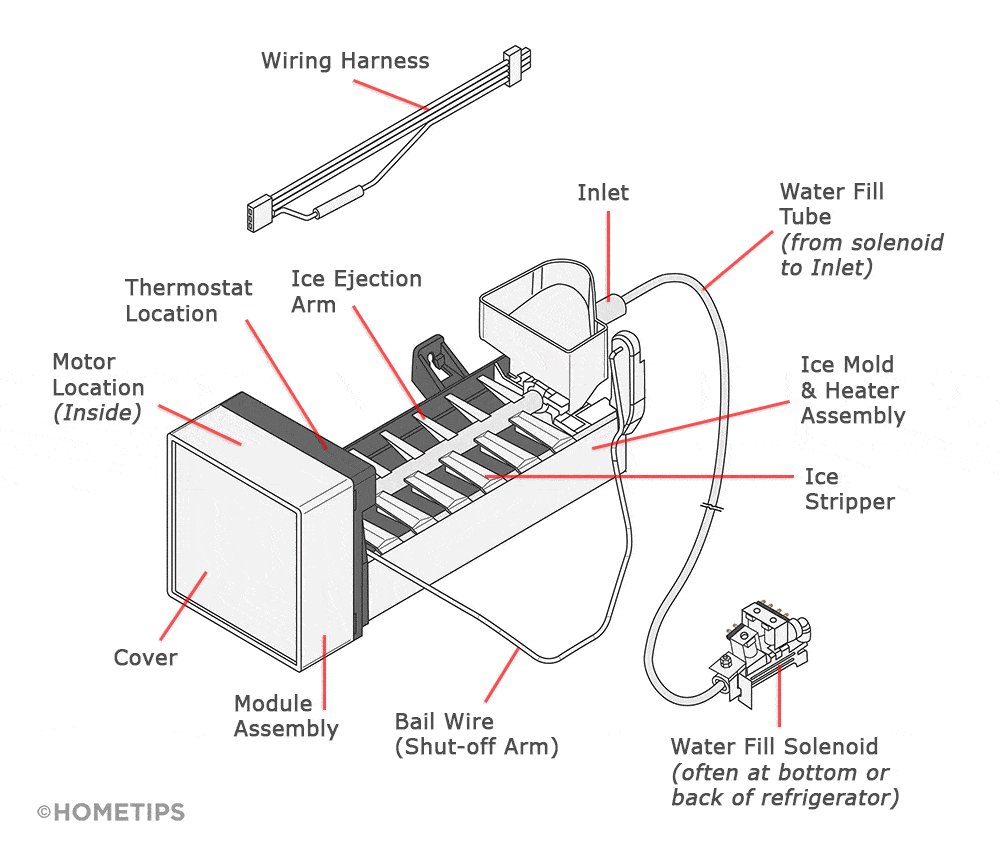How to Clean Ice Maker Water Valve
This post contains affiliate links. As an Amazon Associate, we earn from qualifying purchases.
Your ice maker suddenly stops producing cubes, or you find mysterious puddles forming under your refrigerator. These frustrating issues often trace back to one hidden culprit: a clogged water inlet valve. Mineral deposits and sediment from your household water supply gradually strangle the valve’s flow, leaving you with empty ice bins and potential water damage. Ignoring this problem risks costly repairs or even permanent appliance failure.
This guide delivers the exact steps to clean your ice maker’s water valve yourself—no technician needed. You’ll restore full ice production in under an hour while avoiding common mistakes that turn simple maintenance into a plumbing disaster. By the end, you’ll know precisely how to diagnose valve issues, safely disassemble components, and implement preventive measures that keep ice flowing year-round.
Spotting Valve Blockage Symptoms Early
Reduced ice production is your first warning sign—your bin fills slower than usual or stops entirely despite hearing the ice maker cycle. Water pooling under your fridge signals valve seepage, while no water entering the ice mold indicates complete blockage. Solid ice jams in the fill tube reveal valve leakage that freezes overnight.
These issues stem from four specific causes: hard water mineral deposits choking flow paths, sediment clogging the inlet screen, calcium scale coating internal components, or corrosion damaging valve seals. Homes with water hardness above 7 grains per gallon face these problems 3x more often. Don’t wait for total failure—address symptoms at the first sign of trouble.
Gather These Exact Tools Before Starting
Critical supplies you can’t skip:
– Adjustable wrench for water line connections
– Phillips and flathead screwdrivers (size varies by model)
– 2+ cups undiluted white vinegar for dissolving mineral deposits
– Soft-bristled brush (an old toothbrush works perfectly)
– Clean lint-free cloths for drying components
Pro upgrades for faster results:
– Teflon tape for leak-proof reassembly
– Smartphone to photograph wire positions
– Bucket to catch residual water
– Replacement valve (keep on hand if cleaning fails)
Never attempt this job with improvised tools like metal picks or harsh chemicals—these scratch precision surfaces and worsen leaks. Stick to vinegar and soft brushes for safe, effective cleaning.
Power Down and Isolate Water Supply
Skipping these steps risks electrocution or flooding:
1. Cut power at the circuit breaker—not just the fridge switch—to eliminate shock hazards
2. Locate your water shutoff (typically behind the fridge or under kitchen sink)
3. Turn valve clockwise until fully closed—test by opening the water dispenser
4. Drain residual water by running the dispenser until flow stops
5. Lay towels around the work area—expect ½ cup of spillage during disassembly
Critical warning: Never touch valve connections with power or water active. One slip could flood your kitchen or damage electrical components. Verify both systems are isolated before proceeding.
Locate Valve and Remove Safely

Find your valve in 60 seconds: Pull the refrigerator forward and inspect the rear lower corner. Most valves are rectangular plastic or metal units with 2-3 water lines and electrical terminals.
Removal sequence:
1. Remove rear access panel (usually secured by ¼-inch hex screws)
2. Take photos of wire positions and water line connections
3. Disconnect electrical terminals by pressing release tabs—never yank wires
4. Place bucket under valve before loosening water lines
5. Use wrench on compression fittings—turn counterclockwise just until loose
6. Disconnect ice maker line (push-to-connect fittings require gentle squeeze-and-pull)
7. Remove mounting screws securing valve to frame
If lines resist disconnecting, don’t force them. Apply vinegar to corroded fittings and wait 10 minutes before retrying.
Inspect for Damage Before Cleaning

Focus on these critical areas:
– Inlet screen: Check for rust particles or white crust blocking mesh openings
– Valve body: Look for cracks, green oxidation, or mineral trails indicating leaks
– Rubber diaphragm: Verify no tears or deformations affecting seal integrity
– Solenoid coil: Ensure terminals show no corrosion or burn marks
Pro tip: Hold the screen against bright light—if you can’t see through mesh openings, mineral buildup is severe. This screen catches 90% of contaminants, so prioritize its cleaning. Never disassemble sealed valves—this voids warranties and ruins internal calibration.
Deep Clean Valve Components Properly
Soaking protocol for maximum effectiveness:
1. Submerge inlet screen and removable parts in undiluted white vinegar
2. Soak 30 minutes minimum—extend to 4 hours for heavy mineralization
3. Agitate container every 15 minutes to dislodge stubborn deposits
4. Gently scrub with soft brush, focusing on mesh intersections
5. Clean internal passages with bristles—never use metal tools
Critical rules:
– Never use bleach or abrasives—they degrade rubber seals
– Avoid disassembling sealed units—most modern valves are non-serviceable
– Skip harsh scraping—scratches create new leak paths
Vinegar dissolves calcium without damaging components. For extreme cases, add 1 tablespoon of citric acid to boost cleaning power.
Rinse and Dry Components Completely
Incomplete drying causes electrical shorts:
1. Rinse all parts under warm running water for 2+ minutes
2. Verify screen clarity by backlighting—no visible obstructions
3. Shake vigorously to remove trapped water
4. Air-dry on lint-free cloth for 30+ minutes
5. Confirm full dryness by touch before reassembly
Pro move: Use compressed air to blow water from tiny crevices. Never reinstall damp components—moisture causes immediate electrical failure.
Reinstall Valve and Verify Function

Follow this leak-proof sequence:
1. Position valve in original location—align mounting holes precisely
2. Hand-tighten screws before final tightening—overtightening cracks plastic
3. Reconnect water lines until fittings click audibly
4. Apply Teflon tape to threaded connections (2 wraps maximum)
5. Reattach wires matching your reference photos
6. Slowly open water supply while watching connections
7. Restore power and wait 15 minutes for first cycle
Test for success: Listen for the valve’s distinct click followed by 5-10 seconds of water flow. Monitor the first ice cycle—full production should resume within 90 minutes. Check under the fridge hourly for leaks during initial operation.
Recognize When Replacement Beats Cleaning
Replace immediately if you see:
– Cracks in valve body or green corrosion on terminals
– No magnetic pull when powering solenoid (test with small screwdriver)
– Persistent leaks after proper reinstallation
– Less than 50% flow improvement post-cleaning
Hard water households (10+ grains/gallon) should replace valves every 5 years regardless of symptoms. Use exact OEM part numbers—mismatched valves cause pressure mismatches and recurring failures.
Prevent Future Valve Failures Proactively
Water quality fixes that work:
– Install fridge-specific filter changed every 6 months (quarterly in hard water areas)
– Add whole-house softener if water hardness exceeds 7 grains/gallon
– Run water dispenser 5 seconds weekly to flush stagnant water
Maintenance schedule by usage:
| Household Type | Cleaning Frequency |
|—————-|———————|
| Daily ice users | Every 6 months |
| Standard families | Annually |
| Well water systems | Quarterly |
This simple routine prevents 80% of valve failures. Always test water hardness annually—your local utility report provides this data.
Fix Fill Tube Freezes Caused by Valve Seepage
Thaw and prevent recurring ice jams:
1. Melt blockage with hair dryer on low setting (never use sharp objects)
2. Verify valve isn’t leaking during off cycles—seepage causes overnight freezing
3. Replace valve if fill tube freezes repeatedly after cleaning
Advanced check: Test valve solenoid resistance with a multimeter—it should read 200-500 ohms. Readings outside this range indicate electrical failure requiring replacement.
Know When to Call Professionals
Stop and call a technician if:
– Refrigerator is under warranty (DIY voids coverage)
– Copper water lines need modification
– Control board error codes appear
– Water pressure tests below 20 psi at connection point
Temporary solutions: Fill ice trays manually or use a countertop maker while scheduling service. Always keep your main water shutoff location memorized—seconds count during emergencies.
Final Tip: After cleaning, run your water dispenser for 5 seconds weekly to prevent stagnation. This simple habit extends valve life by 40% and ensures crystal-clear ice. If your ice maker still underperforms after proper cleaning, replacement is the only reliable solution—don’t waste time on repeated cleaning attempts. With this maintenance complete, you’ll enjoy consistent ice production for months to come.
